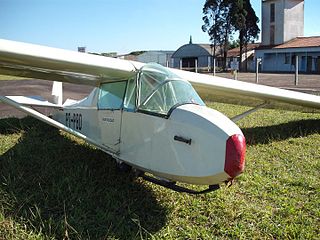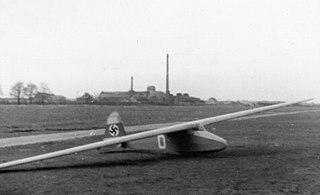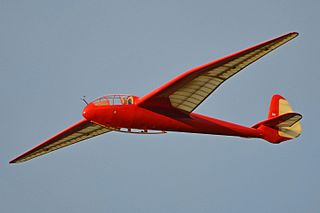
The ASK 13 is a two-seater glider that was built by German sailplane manufacturer Alexander Schleicher Gmbh & Co. It was and still is widely used for basic training of glider pilots.

The Schleicher K 8 is a single-seat glider designed by Rudolf Kaiser and built by the Alexander Schleicher company of Germany.

The Schleicher ASK 18 is a single-seat sailplane that was built by the German manufacturer Alexander Schleicher GmbH & Co. It was designed to be a sturdy aircraft for inexperienced solo pilots and so uses a simple and rugged construction and has docile handling characteristics.

The KW-1b Quero Quero is a sailplane that was produced in Brazil in the 1970s and 1980s. It is a conventional, single seat design of wooden construction. The undercarriage is a fixed monowheel, and construction is of wood throughout.

The Slingsby Type 42 Eagle was a two-seat glider designed in England from 1952.

The Neiva B Monitor, also designated B-2, is a Brazilian tandem two-seat glider aircraft designed and manufactured by Indústria Aeronáutica Neiva between 1945 and 1955 for primary training and general flying.

The Akaflieg München Mü13 Merlin and Akaflieg München Mü13 Atalante were gliders designed and built in Germany from 1935. A motor-glider version of the Merlin was converted by the addition of a small engine in the nose, as the Mü13M Motormerlin. Post-war development as the Mü13E entered production as the Scheibe Bergfalke.

The SZD-24 Foka (Seal) was a single-seat high-performance aerobatic glider designed and built in Poland in 1960.

The Scheibe Bergfalke is a German glider designed by Egon Scheibe as a post-World War II development of the Akaflieg München Mü13 produced before and during the war.

The IS-5 Kaczka was a single-seat canard research glider designed and built in Poland from 1948.

The Slingsby Type 45 Swallow was designed as a club sailplane of reasonable performance and price. One of the most successful of Slingsby's gliders in sales terms, over 100 had been built when production was ended by a 1968 factory fire.

The Slingsby T.13 Petrel was a British single-seat competition glider built by Slingsby Sailplanes just before World War II.
The Kometa-Standard was a Standard Class glider, designed and built in Bulgaria in the early 1960s. Thirty were flown by local gliding clubs.

The Caudron C.800, at first also known as the Epervier is a French two seat training glider, designed and first flown during World War II and put into large scale post-war production. It was the dominant basic training glider with French clubs until the 1960s and several still fly.
The IS-4 was a high performance glider designed by Iosif Şilimon and built in Romania in the late 1950s at the URMV-3 factory at Braşov.
The Civil Aviation Department Ashvini was the first two-seat glider designed and built in India. It was produced in small numbers in the early 1960s.
The Bréguet Br 902 Cinzano was a French training glider produced in the 1950s by Société anonyme des Ateliers d'aviation Louis Bréguet
The Oškinis BRO-11 was a primary glider designed in the USSR. It was produced in large numbers from the 1950s.
The IPE KW-2 Biguá is a sailplane that was produced in Brazil in the 1974.

The Embraer EMB 400 Urupema initially called IPD 6505 Urupema, is a Brazilian glider developed at Instituto Tecnológico de Aeronáutica, São José dos Campos, in 1964, and later produced by Embraer.














